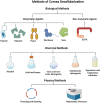A proposed model of xeno-keratoplasty using 3D printing and decellularization
- PMID: 37799970
- PMCID: PMC10548234
- DOI: 10.3389/fphar.2023.1193606
A proposed model of xeno-keratoplasty using 3D printing and decellularization
Abstract
Corneal opacity is a leading cause of vision impairment and suffering worldwide. Transplantation can effectively restore vision and reduce chronic discomfort. However, there is a considerable shortage of viable corneal graft tissues. Tissue engineering may address this issue by advancing xeno-keratoplasty as a viable alternative to conventional keratoplasty. In particular, livestock decellularization strategies offer the potential to generate bioartificial ocular prosthetics in sufficient supply to match existing and projected needs. To this end, we have examined the best practices and characterizations that have supported the current state-of-the-art driving preclinical and clinical applications. Identifying the challenges that delimit activities to supplement the donor corneal pool derived from acellular scaffolds allowed us to hypothesize a model for keratoprosthesis applications derived from livestock combining 3D printing and decellularization.
Keywords: 3D bioprinting; bioink; cornea; decellularization; recellularization; slaughterhouse waste; xeno-keratoplasty.
Copyright © 2023 Wang, Elbahrawi, Abdukadir, Ali, Chan and Corridon.
Conflict of interest statement
The authors declare that the research was conducted in the absence of any commercial or financial relationships that could be construed as a potential conflict of interest.
Figures




References
LinkOut - more resources
Full Text Sources

